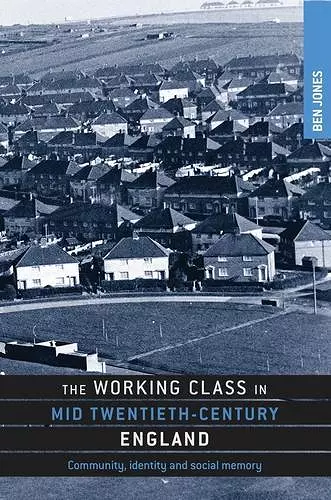The Working Class in Mid-Twentieth-Century England
Community, Identity and Social Memory
Format:Hardback
Publisher:Manchester University Press
Published:25th May '12
Currently unavailable, and unfortunately no date known when it will be back

This book maps how working class life was transformed in England in the middle years of the twentieth century. National trends in employment, welfare and living standards are illuminated via a focus on Brighton, providing valuable new perspectives of class and community formation. Based on fresh archival research, life histories and contemporary social surveys, the book historicises important cultural and community studies which moulded popular perceptions of class and social change in the post-war period. It shows how council housing, slum clearance and demographic trends impacted on working-class families and communities. While suburbanisation transformed home life, leisure and patterns of association, there were important continuities in terms of material poverty, social networks and cultural practices.
This book will be essential reading for academics and students researching modern and contemporary social and cultural history, sociology, cultural studies and human geography.
...illuminating and thoughtful
Here, in consequence, is a work of genuine scholarship, its author's credentials rooted in a readiness to ask the right questions of his cross-generation sample, and an assiduous approach to uncovering civic, community, and counter-culture archives.
Adrian Smith, University of Southampton, Southern History 35 (2013).
Bold and provocative … an impressive argument …In developing his view of the working-class experience, Jones also judicially evaluates his findings against seminal and current historiography on working-class culture, a dimension of the book that makes it a relevant and attractive read.
Brad Beavan, American Historical Review, 2013
Jones presents an impressive example of how, shorn of determinist assumptions, class analysis continues to provide a valuable tool for historians. The author combines an understanding of the material circumstances of men and women’s lives and how they experienced them with an immersion in the narratives and discourses through which these subjects constructed their identities. The result is a convincing argument that class remained central to the lives of English men and women in the middle decades of the twentieth century.
Andrew August, Journal of British Studies, 2013.
Delineates a delicate balance between continuity and change in working-class life in older neighbourhoods and new suburban council estates, and across the whole mid-twentieth century period … The book’s most significant accomplishment is integrating discussion of material change with discursive shifts. In the aftermath of sometimes agonized debates associated with the ‘linguistic turn’, this is an important achievement.
Florence Sutcliffe-Braithwaite, Twentieth Century British History, 2013.
A rich account of the experiences of a working class community … the depth with which the author engages with the topic is impressive and it reveals many different layers of understanding.
David Manley, Planning Perspectives, 2013.
Dilligently researched and well written … a convincing thesis.
Jim Phillips, Economic History Review, 2013.
ISBN: 9780719084737
Dimensions: 234mm x 156mm x 17mm
Weight: 576g
280 pages